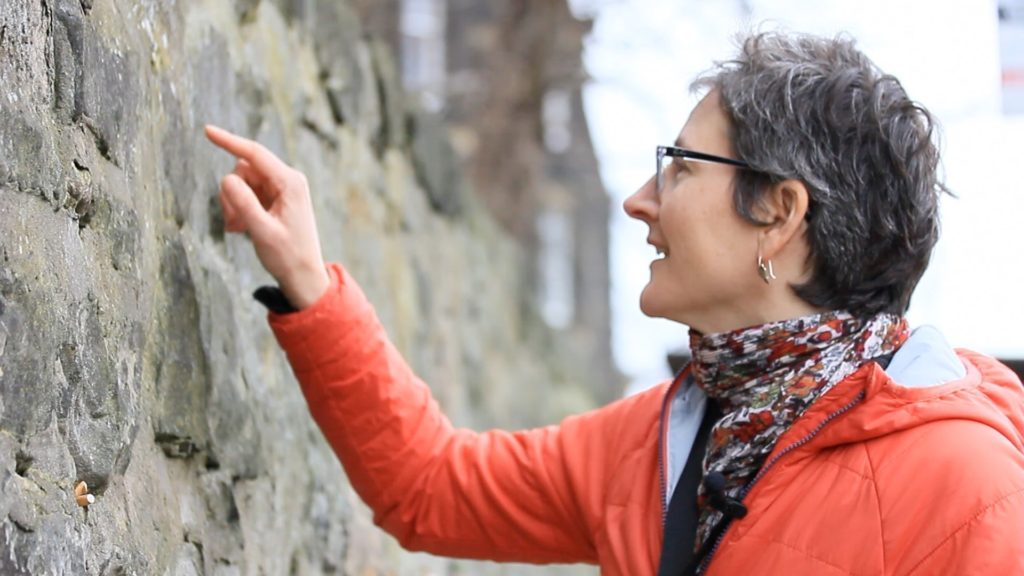Sharing a love of lichens.
“As a biodiversity scientist, I think there are three main themes that must be a part of my focus: diversity, conservation and people. Understanding diversity at different scales is my motivating force, and I’ve always aspired to make a difference in the protection of nature’s under-sung heroes – the plants and fungi that underpin ecosystems. Perhaps the third theme is actually the most important, in fact: without understanding, buy-in and public support, we will have neither conservation nor diversity.
A fascinating model
“My study organisms of choice are lichens – fungi that employ microscopic symbiotic algae or cyanobacteria as their means of food acquisition, and they are able to soak up the sugars their symbionts make from photosynthesis. Lichens are a fascinating model for linking different scales of study: one can go out and inventory lichens as a field biologist, creating a list of ‘who is there’, but it takes molecular work to understand how they tick.
“For most lichens, and especially the rare species, critical information about their biology is missing, particularly about their micro-scale partners and processes. What forces drive their distributions, and do their symbionts control their populations’ spread? How connected are populations? Can we expect dispersal to connect separate woodland patches?
“With colleagues at RBGE and NatureScot, I am part of a project working to answer these questions and help conserve the specialist rainforest epiphytes of the UK’s oceanic fringes on our wet west coast. Scotland has an international responsibility to conserve lichens that are most abundant here and rare or absent across other parts of their ranges, so the work we do will be able to inform the creation of new woodlands.
Experts don’t know everything
“I was trained as a botanist in California and Florida, both hotspots of diversity in the US, working with public and private bodies to survey, describe and work to protect rare species.

“It was all down to doing a botany course at the University of California, Davis, that I switched from the applied science of conservation and management to the underlying question of what to conserve, and what builds terrestrial ecosystems – the plants. I brought my tutor a plant and asked, “Is this such-and-such?” The answer was, “I don’t know; let’s find out!” Straight to the books we went, and I learned that even experts don’t know everything – in fact I had just as much chance of figuring it out as he did, which was a very inspiring thing. I added molecular skills to this during my PhD on lichens, and today I try to weave together my strengths as a whole-organism botanist and mycologist, with my training as an evolutionary and molecular biologist.
“I am honoured to serve as co-chair of the IUCN Lichen Specialist Group, assessing the conservation status of and threats to lichens globally. As a student working on one of only two lichens with official conservation status in the US in 2000, I gave a presentation at one of the group’s meetings. Now, with my co-chair, we organize networks and bring lichen conservation to a wider audience outside lichen channels, and promote red listing internationally.
Building networks
“I have spent a considerable proportion of my time in the last few years teaching about lichens to people of all ages and abilities, from amateur to Master’s and PhD students. For a decade I taught the only week-long public lichenology course, held at the Field Studies Council centre at Kindrogan, Perth and Kinross. I am a trustee and past president of the British Lichen Society, and organised our last conference (online in 2020), with over 300 attendees from all over the world.
“Working on a specialist group like lichens, I feel called to help people discover the diversity of the world around them – indeed probably on their windowsills and pavements – not just in the more famous ecosystems such as rainforests. With a good teacher and a bit of interest, the diversity of life on earth is forever fascinating, and I really enjoy helping people find that fascination.”
Dr Rebecca Yahr is Lichen Biodiversity Scientist at the Royal Botanic Garden Edinburgh and Co-Chair of the IUCN Lichen Specialist Group. Her work is supported by the Scottish Government and others. Find out more here.
This post is part of a series showcasing Scotland’s innovative, high-impact research supporting biodiversity conservation, in partnership with Scottish Government and NatureScot. Read the rest of the series here.
Further reading
Eaton, S., et al. 2018. A method for the direct detection of airborne dispersal in lichens. Molecular Ecology Resources 18(2): 240—250. https://doi.org/10.1111/1755-0998.12731
Corsie, E.I., Harrold, P. & Yahr, R. 2019. No combination of morphological, ecological or chemical characters can reliably diagnose species in the Parmelia saxatilis aggregate in Scotland. The Lichenologist 51(2): 107—121. https://doi.org/10.1017/S0024282919000069
Steinová, J., et al. 2019. Reproductive and dispersal strategies shape the diversity of mycobiont-photobiont association in Cladonia lichens. Molecular Phylogenetics and Evolution 134: 226—237. https://doi.org/10.1016/j.ympev.2019.02.014
Mueller, G.M., et al. 2022. What do the first 597 global fungal red list assessments tell us about the threat status of fungi? Diversity 14(9): 736. https://doi.org/10.3390/d14090736
